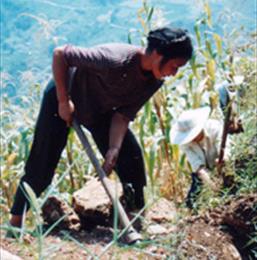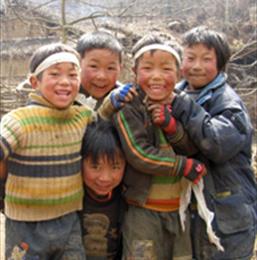Wanping Village, Hanyuan 2001-2004
Wanping Village is part of Pianma Township. It is located across the river from the Hanyuan county seat; it is about an hour and a half drive up to Miaoziping, which is as far as the road goes. From there it is about a 1-1.5 hour walk to reach the nearest hamlet, hamlet 3, where the school is located. About an hour from there on level ground across the way is hamlet 6, one of the 4 primarily Yi minority hamlets in the village. Further up to the furthest 3 hamlets, hamlets 5, 7 and 14, which are also all Yi minority, it is about a 2-3 hour walk up to hamlet 5. From there across on level ground is hamlet 7, another 1-hour walk from hamlet 5. Hamlet 14 is the highest and furthest away, about another 30-45 minute climb up from hamlet 5. The land is extremely steep and rocky.
DORS chose to work only in the four minority hamlets, as they are the poorest and all Yi minority populations. The total number of people in these hamlets is 244. The lowest altitude is about 1600 m at hamlet 3/6, and the highest is over 2000 m in hamlet 14. The largest hamlet is hamlet 5, which has about 22 households, and hamlet 6 follows with 19. Hamlet 14 has about 6 households and hamlet 7 has about 12. The hamlets themselves are relatively compact, in that households are not terribly spread out.
Land is not abundant here and the conditions for the top three hamlets are particularly harsh, which make opportunities for income generating projects limited. The living conditions are extremely poor. There is no paddy in the 4 hamlets, and villagers are allocated 0.5-1 mu per person. There is running water for 3 out of the 4 hamlets though there is no irrigation water. All 4 hamlets are also connected to electricity.
School Construction

This school project was a joint effort between the Education Bureau, the Minorities Department, the Ya'An Minorities Department, Wanping Government, Wanping Central School and Wanping Village Committee. DORS contributed RMB 15,000. The construction was contracted out to a licensed company. The Education Bureau designed the construction plan. The building is a two-storey building with 3 classrooms on each level of 273 square metres.
DORS signed an agreement with Mr Ding (village leader) on 21 August 2003. This stipulated DORS contribution to the project was to be spent only on purchase of materials. It was the responsibility of the villagers to ensure the timely purchase, transport and completion of the school construction. As construction of the school had started before the summer rain, it was agreed that school would stop classes during the construction but that the students would have to attend school during the winter vacation or following summer vacation to compensate.
In the original design, there were no plans to build a toilet, a cemented playground and a wall around the school. However, as the school construction progressed, Village Leader Ding informed us that they intended to add these as part of the construction of the school. He told us that they were taking loans for the additional construction.
The villagers were happy with the new school as students can attend classes in a safe condition now. The teachers were particularly happy with their newenvironment. They have a computer room with two computers, computer lesson is a new subject in their curriculum and only 6th grade students attend these classes. They were particularly proud of their computers and told us that before they could not have computers because of the leaking roofs of the old school.
Picture: Student DORS supported

Teacher accommodation
This project was carried out independently of any governmental departments, but was contingent on the agreement of the Education Department to provide salaried teachers once the dormitory was completed. The Pianma Township Government was also responsible for providing beds and covers for the teachers' accommodations, as well as additional tables and chairs for the classrooms, as more students would be attending school after DORS' support for school fees. Wanping village itself was to provide additional materials such as paint, nails, beds and duvets for the dormitory.
DORS total contribution to the project was 18,250 RMB for the purchase and transportation of materials. Any additional elements such as nails, glass, paint, wires, etc were to be provided by the villagers themselves. In addition, accommodation materials would be provided by the township government. DORS agreed to provide raw materials for the construction. It was decided that they would only need 3 labourers to complete the dormitory, which could be done on a rotating basis between hamlets according to whichever was not working on the road at the same time. In addition, they requested to have a skilled technician present, since it was necessary to have someone with previous experience. Mr Ding organised the labourer to come from Heima Township in Ganluo County; Mr Mu would provide accommodation and food for him.
The teacher dormitory was checked up on many times during the course of construction. The final check showed that the exterior of the building had been completed and whitewashed and 3 teachers were currently living there. The stove for the kitchen had not yet been built, nor had any furnishings for the kitchen/dining area been arranged. One teacher was living in the dining area until his room was completed. Electricity had been connected, and beds and covers had been provided to the teachers. There was no office equipment for the office yet. The extra room was currently being used to hold a class.
In the beginning, we were wary of whether there was support for the school in the higher hamlets. Notably, the teachers and hamlet 6 were in full support, as they stood to benefit the most as nearly all the children from that hamlet attend the school. Originally, they felt that villagers would not want to put in the labour for the construction (as they were also building the road), but later the village worked this out. Therefore, the villagers' support for this project seemed to be varied. Later as construction was underway, we periodically asked villagers what they thought about the project and most of them seemed to support it and be in agreement that this would be good. This may be related to DORS supporting school fees, however, in the higher hamlets, which means they would be able to more directly benefit as opposed to when there were not children from those hamlets attending school. For the most part, villagers in the higher hamlets, while supportive, did not feel any direct connection to the project, as they seemed to think it was more a school project than one directly affecting their lives.
Electricity Transformer Purchase
This was a fairly low maintenance project. Mr. Yang had originally agreed to install the transformer as he was also in charge of managing the electricity in the entire village. However, the village later paid a technician to install it as he had second thoughts about his abilities to do it and was worried about making a mistake. However, he is still in charge of the maintenance and connecting all the households. When we last checked, there seemed to be no problems. Electricity costs are 0.6 p/watt and a base fee of 1.2 RMB every 3 months.
As it is difficult for us to get up there, we were only able to check that the households in hamlet 5 were connected. There was one household that was not yet connected because they had just separated and moved into a new house. One woman had not bought the meter because they could not afford to. All other households were connected and seemed to be very happy to have electricity. We also spoke with members of hamlets 7 and 14, who also said they were connected and there were no problems with it.
DORS total contribution to the project was 7398 RMB for the purchase and transportation of the transformer and concomitant parts.
Road Construction
Wanping was observed to be among the poorest villages DORS had visited, and is one of Hanyuan's registered 'particularly poor' villages. Hamlets 5, 7 & 14 were noted as the poorest hamlets of these villages. The village is almost exclusively Yi minority and is located in a mountainous area, with steep climbs to the hamlets. On visiting the site in November 2000, it was recognised that lack of transportation was one of the bigger and most fundamental problems for the villagers. Villagers described the difficulties involved in transporting goods to sell at the market: a family selling a pig would have to spend 50 yuan on cigarettes and alcohol in order to get help to take the pig down the mountain. Potatoes are transported on horseback, but those families without a horse would lose a considerable portion of their income in paying for transport to the market.
On 25th March 2001, Wanping approached DORS to ask for assistance with building a road. Wanping had already begun working on the road, with assistance from the PAO and the Minorities Dept., but had run out of funds. After holding a meeting with the villages, DORS agreed to assist with part of the funding for the road, and relevant hamlets in Wanping Village agreed to provide the labour at no cost.
The road project was divided into two parts: one part was to build the road up to the primary school in Hamlet 3, and the other part was to improve horse tracks up to Hamlets 5, 7 & 14. The combined length of both parts was 18 km. DORS total contribution to the project was 38,750 RMB for the purchase and transportation of explosives and concomitant parts. In total, 4.512 tons of explosives were purchased. We signed this agreement and distributed the funds in conjunction with another project (see Wanping Transformer Project), and funds were all paid out in one instalment. The funds were given directly to Mr Ding (village leader) and Mr Yang (Party Secretary). The villagers did not make a financial contribution to the project but provided the labour.
Because DORS contribution to this project was minimal, and as it was a part of a larger project with county-wide support, there were very few problems with the actual implementation of it. Half a ton of our total contribution was to be given to hamlets 5, 7, and 14 to construct a wider horse path up to their higher hamlets.
Labour would be carried out on a rotational basis, with each hamlet responsible for labour at different times. Also, those households whose land would be impacted and/or used by the road were financially compensated for it, and this seemed to all be agreed upon beforehand, so that there seemed no real problems with this aspect when we went to check.
Apart from the upper hamlets (5, 7, 14), all the other hamlets were working on the lower road, and during one visit we ran into hamlet 8 villagers who were in the middle of working. They all seemed very grateful for our help and there seemed to be no problems elsewhere with labour. The higher hamlets were all putting in the labour for the construction of the horse path, as they felt this would bring more benefits to them in transporting materials. Half a ton was given to them, and last we checked they had completed about 50% of the road, which was visible from hamlet 3. The remainder they plan to finish after harvest and over the winter seasons.
All the explosives from our contribution were used up within the next few months. Last we checked they were still lacking 3 tons of explosives, but Mr Ding was confident he could find them elsewhere. Progress on this road has been sporadic, based on whenever and whatever resources they can find. It was nearly 60% completed last we checked. The connection from hamlet 3 to hamlet 6 had not yet been completed as it runs through a stream.
Most of the villagers we came across, from both the hamlets we work in and others all seemed to be very enthusiastic about the road and were very grateful for our contribution towards the project. Notably, this will benefit those hamlets that are able to immediately take advantage of the road a great deal, as transportation is a significant problem and contribution to the level of poverty in the village. As for the upper hamlets, 5, 7, and 14, they seem less enthusiastic about the main road, which is one reason why they did not contribute to the labour for it, as they are located another 500 or so meters beyond, and this will only take them so far. However, they are more keen on the wider horse path up to their hamlets, which will only go to hamlet 5, as the others are further, but they feel this will provide many benefits as well.
Butter Bean Loan

Guo Yumei interviewing Wanping villagers
The project provided loans to individual households for them to buy bamboo canes required for the growth of butter beans. The loan was to be repaid after a year, after the butter beans had been sold. Originally, this project was not part of the action plan discussed in the project planning meeting held in April 2001. However, after discussions with the villagers of these 3 hamlets in February 2002, it was found that the interest for this project was high and that the villagers were keen to start immediately after the discussions held. The climatic condition of these three upper hamlets was appropriate for this project.
After the initial discussions, it was agreed that the 3 above-mentioned hamlets would prepare namelists for the interested households in this project. After the namelists were prepared, DORS visited the village and discussed the project in more detail with the interested households, and the amount of loan and the repayment date were set. An agreement with each hamlet was signed after each hamlet chose one representative whose prime responsibility was to ensure that the collections of the loan were on time and to hand over the loans to DORS staff.
On 27 March 2002, two agreements were signed, one with hamlet 5, loaning RMB 8000 to 21 households and one with hamlet 14, loaning RMB 2800 to 7 households. On 03 April 02, a third agreement was signed with hamlet 7, with a total loan of RMB 4800 to 12 households. Most of the households borrowed RMB 400 each, with the exception of 2 households in hamlet 5 who each borrowed RMB 200. Repayment was to be in full.
The price of one bamboo cane was RMB 0.01, therefore with RMB 400, each household bought 4000 bamboo canes. With 4000 bamboo canes, each household grew approximately 700 jin of butter beans, using around 60 jin of seeds which they had.
Harvest was during the 9th and 10th month of the agriculture calendar and butter beans were sold in the 11th month. DORS contribution to the project was a total loan of RMB 15,600 to the three upper hamlets of Wanping Village, notably hamlets 5, 7 and 14.
Most of the project components were funded by Kadoorie Foundation 2001-2004


